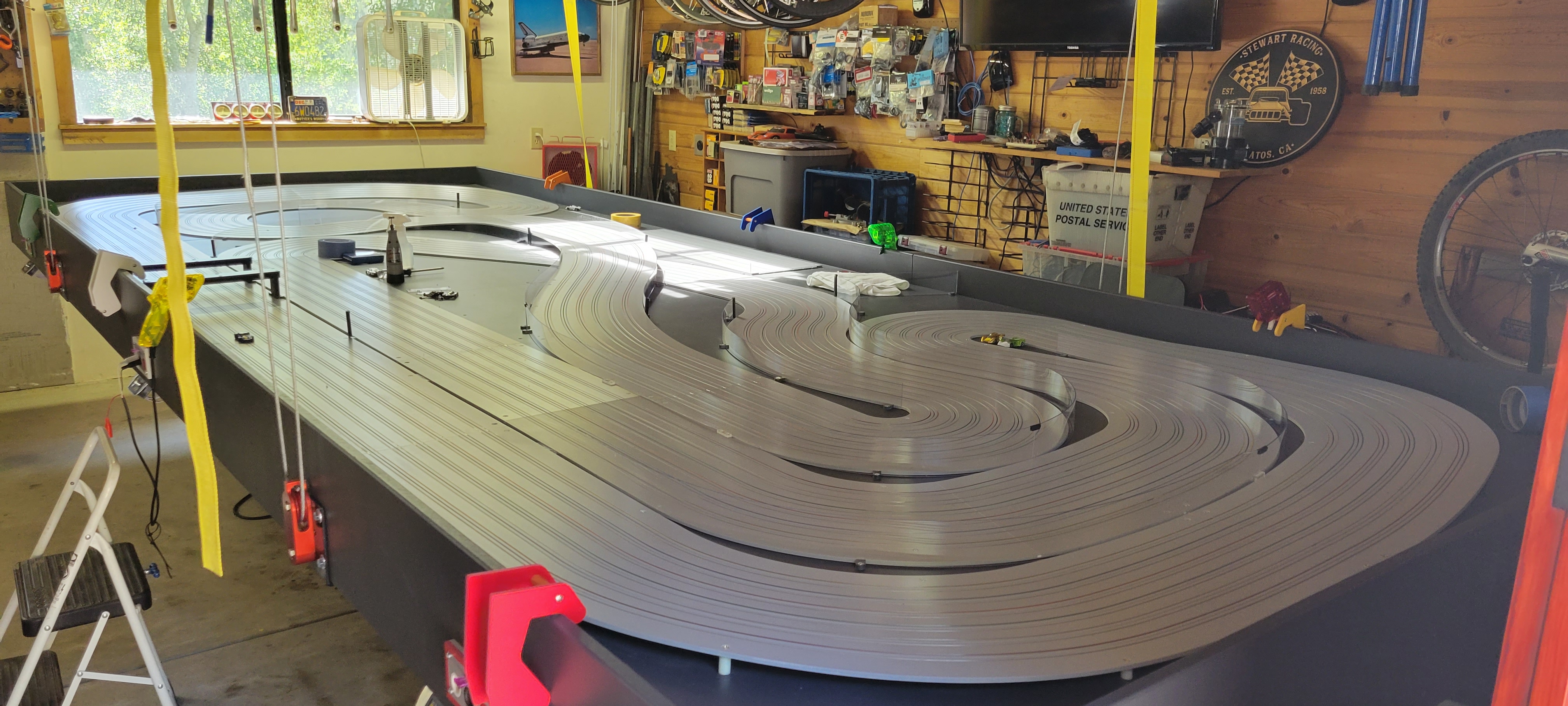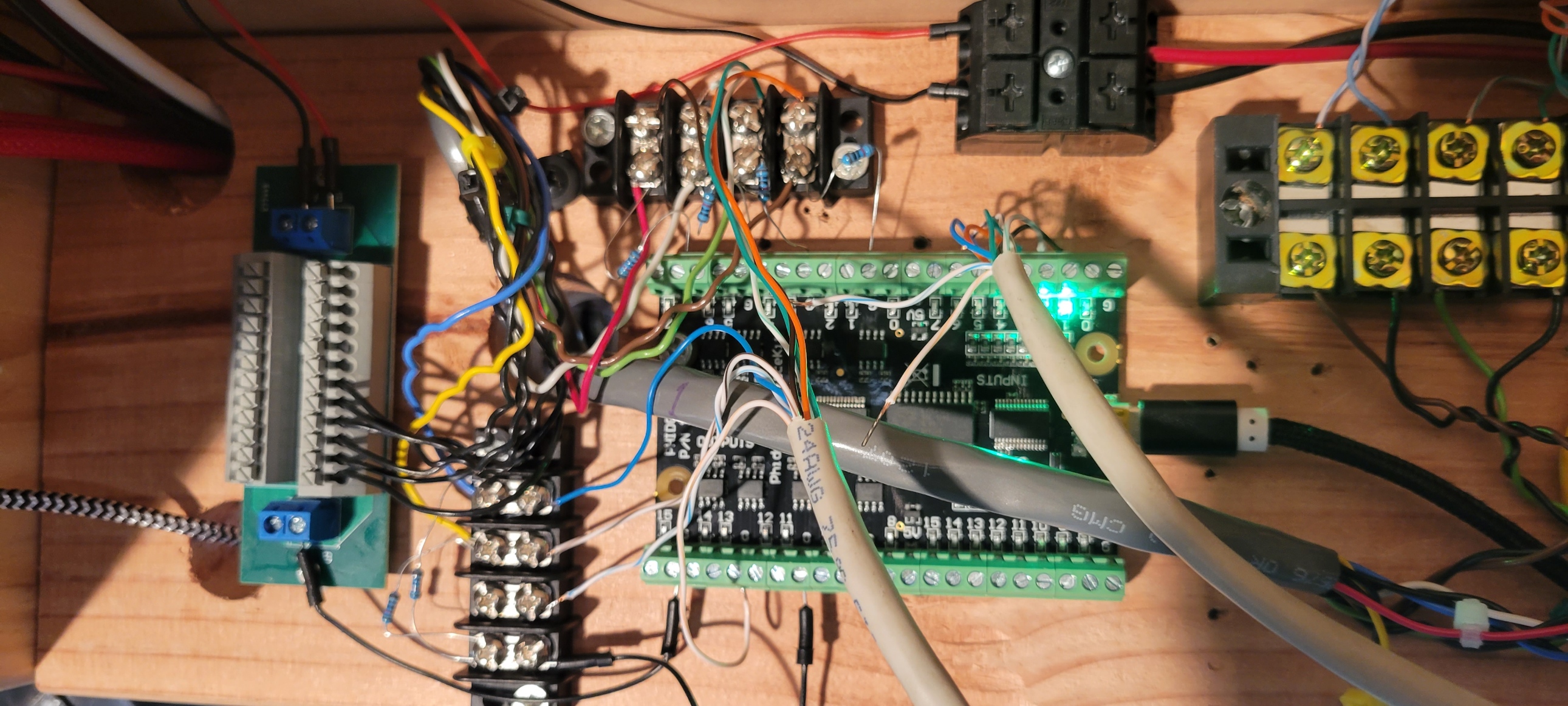
I don’t think I’ve ever dealt with a problem so simple yet so difficult to solve. Last week I had finally gotten the Pit-In gantry to detect the fastest pit entries I could produce. That was cause for celebration, which I did, of course.
Right after my celebration, I simulated a race situation and discovered that SlotTrak was not counting the lap after a refuel. Apparently, the configuration I was employing was not adequately tested by SlotTrak.
I reported this issue to Slottrak and they could not duplicate the problem. Not sure why they couldn’t duplicate it but there was clearly no solution coming from SlotTrak to fix things.
So, I then decided to switch the gantry positions (SlotTrak’s suggestion). The normal position is to have the Pit-In gantry positioned ahead of the Pit-Exit/Lap Counting gantry (Start/Finish). This is how SR2 is configured.
It’s not a trivial thing to swap the positions of the gantries but it was worth a try to see if SlotTrak would work at all. Turns out, it did work and did count the lap after a pit stop. Another major celebration!
However, the original Phidget sensor detection problem reared its ugly head yet again. I thought I had this problem solved but because swapping the gantries meant that the speed through the Pit-Out gantry was a whole lot faster, the setup I had developed no longer worked.
It’s complicated but essentially, if you weren’t pitting and blazed through the two gantries, the pit exit was not detected by the slug Phidget card (in spite of my previous hardware and software mods) and SlotTrak would think you had stopped in the pits even though you had no intention of doing so.
At this point, I’m about to abandon slot car racing and move along to shuffleboard and backgammon. But no, I keep at it while my wife is about to commit me for being way too obsessed with toy cars and ignoring all my other interests and responsibilities. Stupid me, I stayed focused on the problem and kept trying everything I could think of to solve it.
I have no idea why SlotTrak ever decided that Phidget cards are useful for anything and SlotTrak does not support using two Trackmate SCL3 cards for fuel management, which would be awesome. Instead, I’m stuck with this incredibly expensive but ridiculously slow Phidget I/O card. I had gotten it to work as a Pit-In gantry but the speeds coming into the pits are much slower than the speed going through the pits. Again, the Pit-exit gantry has to detect a car coming out of the pits as well as a car going through the pits—at a much higher rate of speed.
In the end, I was able to get the Phidget card to detect both Pit-exit and Pit-through at L4 car speeds. This was accomplished with both pull-down resistors on the IR sensors as well as using a much faster Arduino Mega microcontroller card to capture the IR sensor signals and then send them to the Phidget card slow enough for the slug card to detect and report to the SlotTrak software. Yea, believe it or not, I used a $35 microcontroller card to help a $110 I/O card capture an infrared beam breaking–crazy!
Okay, so my testing shows that my fix works for every scenario except three cars leaving the pits at the same exact time in consecutively numbered lanes. Since I used hardware and software to come up with this solution, I should be able to make it work perfectly but I just don’t think we’ll ever see that particular scenario play out very often, if ever. So, in the interest of staying married to my wonderful wife, I’m done with this project for a while.
I know Ted has a race scheduled at Thunder Road Raceway on April 23. I’d like to get at least six drivers over the following Saturday (April 30) to test the SR3 road course prior to beginning a new racing series.
Please email me at slotn77@gmail.com and let me know if you can make it. No “official” series racing at Stewart Raceway until the tracks are bulletproof.
FYI: The intermittent Pit-In detection problem with SlotTrak on SR2 is not yet fixed. I’ll work on that problem ASAP but it works flawlessly using an Arduino card and Race Coordinator so it is a Trackmate or SlotTrak issue and probably something I can’t fix.
Okay, shut up and drive!


 Well, the saga continues. After three weeks of chasing the pit detection issue, that problem actually turned out to be solvable by something I had already tried. In the end, the IR sensors had to have pull-down resistors to work properly with a Phidget card. Apparently, the Trackmate SCL3 card has built-in pull-down resistors, which is why it works flawlessly.
Well, the saga continues. After three weeks of chasing the pit detection issue, that problem actually turned out to be solvable by something I had already tried. In the end, the IR sensors had to have pull-down resistors to work properly with a Phidget card. Apparently, the Trackmate SCL3 card has built-in pull-down resistors, which is why it works flawlessly.



 Steve may not have seen the single-car detection issue I’m seeing because his lap timing gantry is only 18 inches from the final corner (SR3’s final corner is nearly six feet from the lap timing gantry). However, he did encounter the simultaneous car detection problem, which I duplicated on my track tonight.
Steve may not have seen the single-car detection issue I’m seeing because his lap timing gantry is only 18 inches from the final corner (SR3’s final corner is nearly six feet from the lap timing gantry). However, he did encounter the simultaneous car detection problem, which I duplicated on my track tonight. Another option for solving this would be to add a 1.5-in long piece of black tape to the back of each car. Not sure if everyone would go for that but it is way cheaper and quicker. And, just think…you could paint or otherwise detail the tape for concourse consideration!
Another option for solving this would be to add a 1.5-in long piece of black tape to the back of each car. Not sure if everyone would go for that but it is way cheaper and quicker. And, just think…you could paint or otherwise detail the tape for concourse consideration!
 I don’t have the track sections connected to each other yet but I tested the gantries and all the power control logic by hand and with a test car on one section. Both seemed to work as expected and nothing caught fire.
I don’t have the track sections connected to each other yet but I tested the gantries and all the power control logic by hand and with a test car on one section. Both seemed to work as expected and nothing caught fire. Before I get to the above, I’m going to lift the track to the ceiling and clean out the entire garage. Need to blow and vacuum the whole place out due to all the damn sawdust, wire insulation, tie-wrap debris, etc. Also need to get rid of a bunch of bikes and bike parts. This track takes up a bit more space and will force me to get rid of stuff that has been hanging on the walls or just laying around forever. I also need to wash my motorcycles before the sawdust becomes permanent.
Before I get to the above, I’m going to lift the track to the ceiling and clean out the entire garage. Need to blow and vacuum the whole place out due to all the damn sawdust, wire insulation, tie-wrap debris, etc. Also need to get rid of a bunch of bikes and bike parts. This track takes up a bit more space and will force me to get rid of stuff that has been hanging on the walls or just laying around forever. I also need to wash my motorcycles before the sawdust becomes permanent.